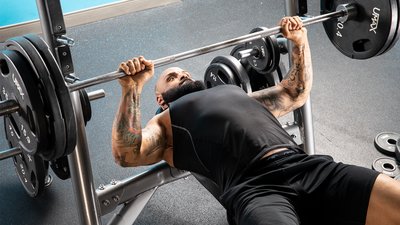Like 99.9 percent of lifters, I've loved bench pressing since I first touched knurled steel back in my teens. At first, I benched for high school football, and because the coveted "250 Club" T-shirt was a must-have. After college, I hit my first official 400-pound bench in a contest—and did it raw. My competitive bench-pressing career peaked in 2000 when I won best lifter at the NPC National Championships with a press of 534 pounds at 289 pounds body weight. I was 32 at the time, and had been benching half my life.
Then, in 2002, I tore my left pectoral tendon from the bone on the eccentric phase of a 405-pound bench. It put me down for a while, but not long; I benched 440 pounds at the 2003 NPC National Championship, then decided to have the tear surgically repaired in 2004. Three months later, I was benching just 250 pounds when my recently reattached tendon torqued my humerus bone with a force I'd never felt in 20 years of lifting, and broke my arm.
This combination of injuries put a major crimp in my lifting (and made changing the diapers of my young twins a unique challenge), but it didn't stop me for good. I didn't touch a weight for five months, but fast-forward five years, and I was able to break the Arizona State USAPL bench press record, just as my kids were entering kindergarten.
What allowed me to go from not thinking I would ever bench again to getting back in the game? Learning the art of building a strong bench without benching, aka conjugate training. I had utilized many Westside principles in my career up to this point, but embracing conjugate training as a long-term approach was essential.
The idea behind conjugate training is that to make improvements in one lift, you need to do more than just practice that lift over and over again. To see better and faster progress, start training a number of other, related lifts that will help you reach that next PR. And yes, it works for the squat, too.
Here were the essential moves to help me get my bench back.
Variation 1: Pin bench presses plus static lockout
The first lift I embraced when getting back into training after my injury was a bench press in a rack, using the safeties to hold the bar at various heights. I picked up this technique from the writings of Louie Simmons (of course), as well as Anthony Ditillo, Brooks Kubik, and Bill West.
The technique was perfect for my situation because it doesn't put eccentric stress on the muscle—the phase of the exercise during which I had originally torn my pec muscle. Science will tell you that the greatest muscle stress is when you're lowering the weight in the eccentric phase. By limiting that phase, I could start benching again, with less risk of re-injury.
Here's how I approached it:
- Using a power rack, set the safety pins right above your chest.
- Don't aim for reps, just build up to the heaviest single you can do that day, in the style of Westside max-effort training.
- Start each rep from a dead stop. Once you lock out at the top of the rep, hold the weight for 5-10 seconds to give your body a safe overload stressor while you're in the strongest position possible—the lockout.
- I liked working in a four-week cycle, building up to a max-effort single during each cycle, but from different heights: 2, 4, and 6 inches above the chest.
Variation 2: Standing military press
In addition to rack bench presses, I began to focus heavily on standing military presses while training with Josh Bryant, powerlifter and strongman extraordinaire, who once pressed 445 pounds—a feat that needs to be seen to be believed.
All of the great—and tall—raw bench pressers, including Kaz, Pat Casey, and Josh, have always been amazing at military presses. These presses are great for keeping your upper body healthy and strong. By adding them into my routine after 20 years of focusing almost exclusively on the bench press, I felt like I breathed new life into my training—and rebuilt my foundation. Fifteen months after breaking my arm, I built up to military pressing 320 pounds in a contest.
Variation 3: Incline bench press
After all my upper-body injuries, the press that feels best to me is the barbell incline bench press. I did a strict 390 back in the day, and to those who say the incline doesn't transfer to the flat bench, I respectfully disagree. To this day, I love to incline and can easily get to within 50 pounds of my best flat bench press. Lifting legend Jon Cole, who did 500 pounds on incline in the '70s, continues to inspire me, as does Leroy Walker, who did an easy 605 pounds.
Another incline hero is 2017 World's Strongest Man Eddie Hall. He can handle the incline for reps with 500 pounds or more, and has seen it pay off in a 617 flat bench in competition.
Variations 4 and 5: Floor presses and reverse band benches
To help round out my conjugate training, I also applied two Westside-based exercises, floor presses and reverse band benches. Both exercises took stress off my recovering pectorals and allowed me to regain pressing power while not "chewing up" my high mileage pectoral-delt tie-ins.
The reverse band bench (also known as the "future" method because you load the bar with a weight you hope to be able to lift in the future, without help from the bands) was especially helpful, as it allowed me to handle weights that were 25-50 pounds over and above what I was able to bench at the time. This is overload with a full range of motion, with the bands partially deloading about halfway to lockout to work your triceps with weights you wouldn't normally handle in isolated triceps training.
Presses to balance the pulls
To balance out all of this pressing work, I did plenty of pulling, too—and not just as a side dish. I competed in the US Strongest Man Contest in a pair of lifts, the trap bar deadlift and weighted neutral-grip pull-up, both of which inadvertently built up my bench in the process.
The trap bar deadlift strengthens your traps and deltoids, while weighted pull-ups with a parallel grip work your lats. Both are essential for healthy, strong pressing. In competition, I was able to pull my 275-pound self up to the measuring level with 75 pounds added to my body. Josh could add more than 130 pounds. Freak!
Conjugate training keeps it challenging—and fun!
In lifting, as in the rest of life, what doesn't challenge you will not change you. Above all else, the conjugate style of training has allowed me to maintain a positive attitude, empowering me to figure out what exercises my body needed to perform best. And it works for not only the physical aspect of training, but the mental one as well—a combination of exercises that challenges my weaknesses both physically and mentally.
It starts with being honest with yourself and identifying your weaknesses. Then, try exercises that can turn these weaknesses into strengths. Choose exercises that both challenge you and are enjoyable enough to keep you coming back for more. If flat benching causes you pain or doesn't mentally stimulate you, attack exercises that do.
Years ago, Louie Simmons described in a video how training needed to be fun. He talked about how, by constantly varying the stimulus, a good training plan should keep you in a positive frame of mind and feeling like you're always beating the weights.
If your bench is stagnant, find other exercises that allow you to progress, and give them hell. Then, when you circle back after making gains elsewhere, you'll be surprised at how much your bench has improved!

